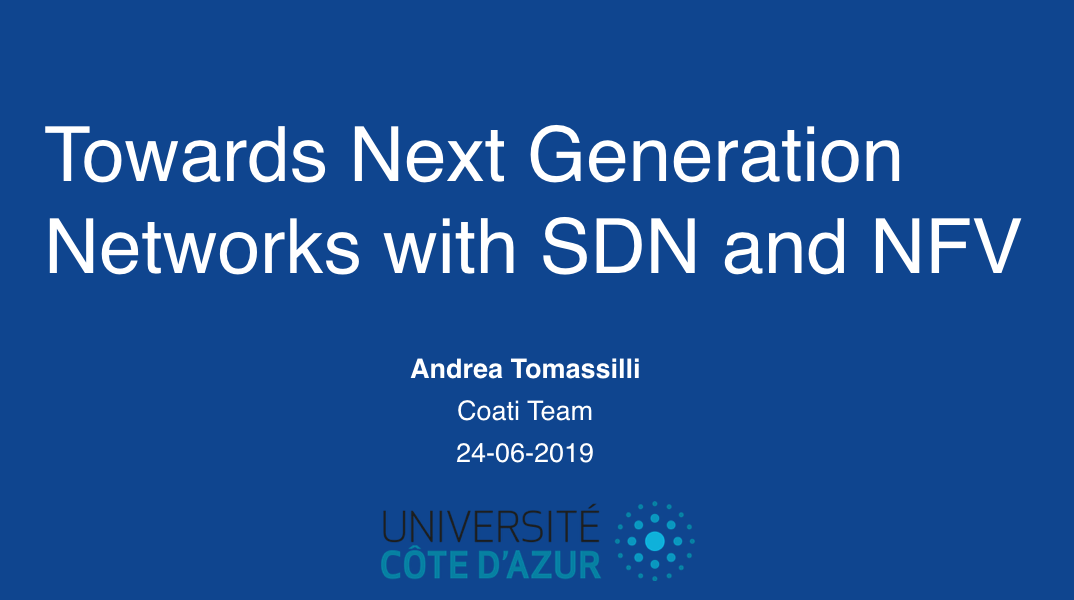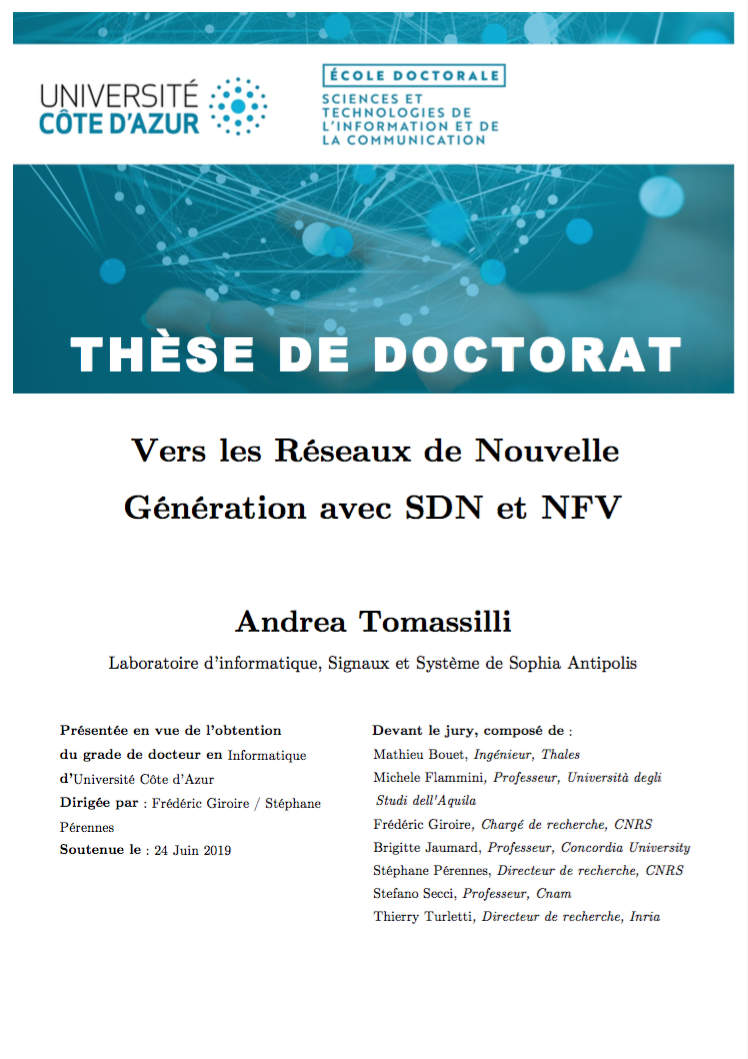
Manuscript (in English)

| Rapporteurs : | Matthieu BOUET | Ingénieur, Thales |
| Stefano SECCI | Professeur, Cnam | |
| Examinateurs : | ||
| Michele FLAMMINI | Professeur, Universita degli Studi dell'Aquila | |
| Frédéric GIROIRE | Chargé de recherche, CNRS | |
| Brigitte JAUMARD | Concordia University (Canada) | |
| Stéphane Pérennes | Directeur de recherche, CNRS | |
| Thierry Turletti | Directeur de recherche, Inria |
Les progrès récents dans le domaine des réseaux, tels que les réseaux logiciel(SDN) et la virtualisation des fonctions réseaux (NFV), modifient la façon dont les opérateurs de réseaux déploient et gèrent les services Internet.D’une part, SDN introduit un contrôleur logiquement centralisé avec une vue globale de l’état du réseau. D’autre part, NFV permet le découplage complet des fonctions réseaux des appareils propriétaires et les exécute entant qu’applications logicielles sur des serveurs génériques. De cette fa ̧con,les opérateurs de réseaux peuvent déployer dynamiquement des fonctions réseaux virtuelles (VNF). SDN et NFV, tous deux séparément, offrent aux opérateurs de nouvelles opportunités pour réduire les coûts, améliorer la flexibilité et le passage à l’échelle des réseaux et réduire les délais de mise sur le marché des nouveaux services et applications. De plus, le modèle de routage centralisé du SDN,associé à la possibilité d’instancier les VNF à la demande, peut ouvrir la voie à une gestion encore plus efficace des ressources réseaux. Par exemple, un réseau SDN/NFV peut simplifier le déploiement des chaînes de fonctions de services (SFC) en rendant le processus plus facile et moins coûteux.Dans cette thèse, notre objectif était d’examiner comment tirer parti désavantages potentiels de combiner SDN et NFV. En particulier, nous avons étudié les nouvelles possibilités offertes en matière de conception de réseau, de résilience et d’économies d’énergie, ainsi que les nouveaux problèmes qui surgissent dans ce nouveau contexte, comme l’emplacement optimal des fonctions réseaux. Nous montrons qu’une symbiose entre le SDN et le NFV peut améliorer la performance des réseaux et réduire considérablement les dépenses d’investissement(CapEx) et les dépenses opérationnelles (OpEx) du réseau.
Recent advances in networks such as Software De ned Networking (SDN) and Network Function Virtualization (NFV) are changing the way network operators deploy and manage Internet services. On one hand, SDN introduces a logically centralized controller with a global view of the network state. On the other hand, NFV enables the complete decoupling of network functions from proprietary appliances and runs them as software applications on general{purpose servers. In such a way, network operators can dynamically deploy Virtual Network Functions (VNFs). SDN and NFV, both separately, bring to network operators new opportunities for reducing costs, enhancing network flexibility and scalability, and shortening the time-to-market of new applications and services. Moreover, the centralized routing model of SDN jointly with the possibility of instantiating VNFs on{demand may open the way for an even more efficient operation and resource management of networks .For instance, an SDN/NFV-enabled network may simplify the Service Function Chain (SFC) deployment and provisioning by making the process easier and cheaper. In this study, we aim at investigating how to leverage both SDN and NFV in order to exploit their potential bene ts. We took steps to address the new opportunities o ered in terms of network design, network resilience, and energy savings, and the new problems that arise in this new context, such as the optimal network function placement in the network. We show that a symbiosis between SDN and NFV can improve network performance and signi cantly reduce the network's Capital Expenditure (CapEx) and Operational Expenditure (OpEx).
In this thesis, we focus on the challenges brought by these two paradigms for the deployment of EAR policies. We dedicated the first two parts to the SDN paradigm. We first study the forwarding table size constraints due to an increased complexity of rules. We then study the progressive deployment of SDN devices alongside legacy ones. We focus our attention on the NFV paradigm in the last part, and more particularly, we study the Service Function Chaining problem.